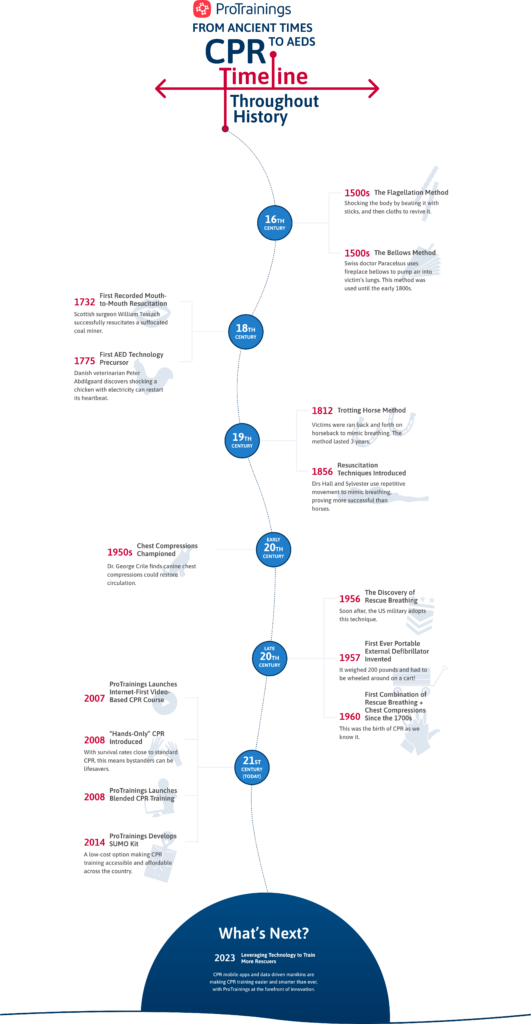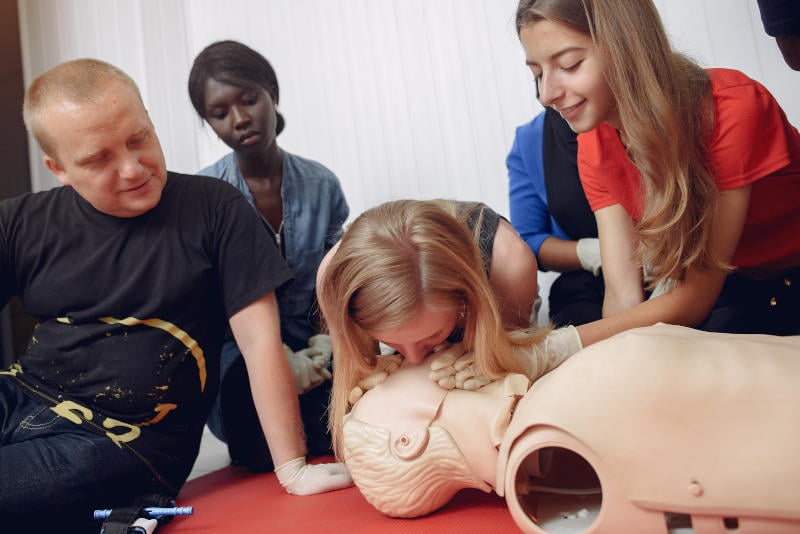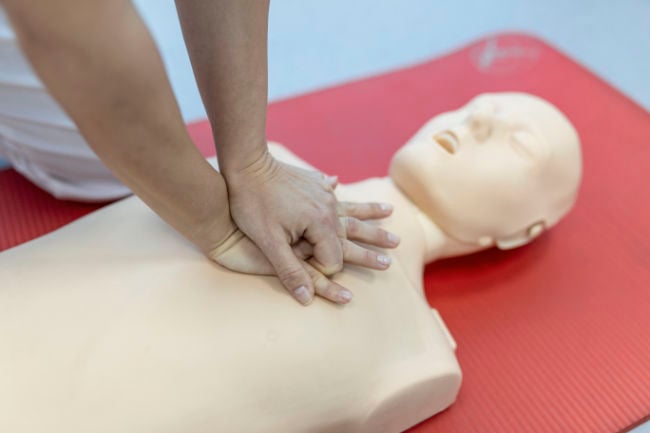Table of Contents
- The Early History of CPR: Ancient Chest Compressions
- CPR in the 18th Century: Animal Resuscitation in Humans
- CPR in the 19th Century: A Precursor to Modern CPR
- CPR in the Early 20th Century: From Dog Massage to the AHA
- CPR in the Late 20th Century: A 200-Pound Defibrillator
- Modern CPR & Life-Saving Programs: “Hands-Only” Saves Lives
- The Future of CPR: SUMO Kits & Online Certification
Cardiopulmonary resuscitation, or CPR, is a technique invented to restore blood circulation and breathing in an individual who has stopped breathing and whose heart has stopped beating.
Knowing how to properly administer CPR can help save a life in a matter of minutes. But when was CPR invented, and how has it changed over the years?
From the ancient Egyptians to modern-day doctors, both professionals and laypeople have been using variations of CPR throughout history.
Naturally, CPR techniques have evolved considerably as experts have studied (and continue to study) the best ways to use the skill to delay organ damage and save lives.
Read on for the answers to all your most pressing CPR-related questions — like when was CPR invented and how has it changed over time? — as well as what the future looks like for this life-saving skill.
When Was CPR Invented: The Early History of CPR
The earliest known reference to CPR-like techniques can be found in the writings of the ancient Egyptians, who used a combination of chest compressions and mouth-to-mouth ventilation to revive drowned victims.
The technique was also used by the ancient Greeks and Romans but was not widely practiced or considered a formal medical procedure.
So, when was CPR invented, exactly?
While we can’t trace the invention of CPR to an exact date, we can trace variations of its use back to the 18th century. The modern version of the technique — that we know and use today — however, was developed in the 1960s.
Get a visual of CPR’s history and development with ProTrainings’ classroom-ready infographic, which takes you from ancient times to AEDs.

CPR Before & During the 18th Century
Although the effectiveness was questionable, the “Bellows Method” was first used by a Swiss physician named Paracelsus in the early 1500s. The method involved inserting the end of a bellows into the mouth of the victim in an attempt to force air into the lungs.
Another, slightly more violent, process called the flagellation method was also used during the 1500s. It involved whipping the victim to try and shock them back to life. While the thought behind it could be seen as a precursor to the modern AED electric shock, it was rarely successful.
According to the American Heart Association (AHA), the earliest recorded instance of CPR techniques that are still around today dates back to 1732, when Scottish surgeon William Tossach used mouth-to-mouth to resuscitate a suffocated miner.
Mouth-to-Mouth Invented in 1732
In 1740, the French Academie de Sciences officially took a stance recommending the procedure for drowning victims.
In 1775, a little further east, Danish veterinarian Peter Abildgaard discovered that shocking a chicken’s lifeless body could restart its heartbeat. This is the first evidence of techniques still used today with modern AED technology.
CPR in the 19th Century
At the start of the 19th century, resuscitation techniques still had a ways to go. In 1812, lifeguards would hoist drowning victims onto the backs of horses, running the horse and victim up and down the beach. The thumping motion of the victim’s body against the horse would alternately compress and relax the chest cavity. The procedure was banned shortly after in 1815.
Revolutionary Resuscitation Techniques Introduced
Almost half a century later, two London physicians, Marshall Hall and Henry Sylvester, introduced their respective resuscitation techniques almost 100 years before CPR was invented.
Hall’s approach, developed in 1856, involved manually turning the victim from lying on his or her back to lying on his or her side.
Later, he added a step involving putting pressure on the area of the body between the neck and the abdomen, known as the thorax.
Just a few years later in 1858, Silvester developed another position-changing method that involved laying the victim on his or her back, raising the arms above the head, then crossing the arms over the chest — and repeating the process over and over.
By raising the arms above the head, the victim’s chest expanded. Lowering the arms over the chest expelled the air, thereby simulating a breath, in theory.
These two methods were far from perfect, but they brought physicians far closer to the techniques we use today. According to the AHA, both methods became “the most commonly used forms of artificial respiration until the early 20th century.”

Later, in Germany in 1874, anatomist Moritz Schiff studied the influence of the nervous system on the bloodstream in cases of cardiac and respiratory arrest and how massaging the heart during surgery benefitted circulation.
Next, in 1878, German pharmacologist Rudolph Boehm discovered that applying external compressions over the heart successfully facilitated blood circulation in cats.
Chest Compression Technique Applied to Humans in 1891
Building on Boehm’s work, German surgeon Dr. Friedrich Maass applied the principles of external chest compression to humans in 1891. Maass suggested that compressions combined with ventilation (assisted breathing), could be a promising approach.
However, others in the medical community were skeptical and continued to use open-heart massage as the preferred method for sustaining life during a cardiac event.
It wasn’t until the mid-20th century that CPR — including the combination of compressions and ventilation that Maass suggested — became widely known and used.
CPR in the Early 20th Century
In the early 20th century, further animal experimentation from Dr. George Crile of Cleveland, Ohio, showed that chest compressions were able to facilitate circulation in dogs. Dr. Crile, like colleagues before him, urged the medical community to switch to this method rather than continuing with invasive open-heart massage.
One of the biggest barriers to widespread acceptance of chest compressions as a valid technique was the limitations in communication and sharing of ideas and research in the early 1900s and prior.
To combat this, the American Heart Association was formed by six cardiologists who gathered for their first meeting in 1924. The organization furthered the sharing of knowledge by publishing Circulation, a cardiovascular scientific journal, starting in 1950.
American Heart Association Formed in 1924
Soon after the AHA was formed, in 1933, Johns Hopkins University researchers unknowingly replicated Dr. Crile’s work and confirmed the success of chest compressions in assisting circulation with 100 canine subjects.
While chest compressions are often seen as the core life-saving technique of CPR, they serve to sustain circulation while the heart is stopped.
Other scientists continued to work on understanding how to fully restart the heart to resume beating, including Ohio heart surgeon Dr. Claude Beck who used an electric defibrillator to successfully restart a patient’s heart in 1947. The shock was applied to an exposed heart but would soon give way to the external defibrillation we know today.
CPR in the Late 20th Century
In 1956, Drs Peter Safar, James Elam, and Archer Gordon proved the effectiveness of mouth-to-mouth resuscitation — blowing air into the lungs of a person who had stopped breathing. This discovery would later be known as “rescue breathing,” just four years before CPR was invented.
First Successful External Defibrillation Performed in 1956
Meanwhile, cardiologist Dr. Paul Zoll of Harvard University performed the first successful external defibrillation to restart a patient’s heartbeat without invasive procedures. The move was groundbreaking and made saving someone’s life possible without putting them at significantly greater risk of infection due to opening the chest cavity.
Just a year later, in 1957, the United States military decided to adopt the rescue breathing technique to help save soldiers and other military personnel on duty.
First Ever Portable External Defibrillator Invented
At the same time, the first ever portable external defibrillator was invented by Drs Kouwenhoven, Jude, and Knickerbocker at Johns Hopkins University.
While the invention was a profoundly valuable contribution to medical science, it still had its limitations — namely that the device weighed 200 pounds and had to be wheeled around on a cart.
The Birth of CPR in 1960
Alongside their work on the portable defibrillator, the three Johns Hopkins surgeons were the first to combine chest compressions with rescue breathing to resuscitate an incapacitated cardiac arrest victim in 1960.
This was the first instance of the two techniques — which had previously been used separately since the 1700s — being used together.
The combined technique — now referred to as CPR — was first introduced to the public and adopted as a standard procedure for reviving victims of cardiac arrest.
To help train physicians on how to use CPR, a life-size human manikin was developed in 1960 by the trio of Johns Hopkins physicians in collaboration with Åsmund Lærdal, a toymaker from Norway.
By 1966, medical professionals — in combination with the AHA and the American Red Cross — began the process of creating standardized guidelines for effective CPR training.
Dr. Leonard Cobb of the University of Washington recognized the importance of everyone – not just physicians – knowing CPR and started to train laypersons. He trained more than 100,000 individuals in two years.
Modern CPR & Life-Saving Programs
About a decade after 911 emergency calling was introduced in the United States, King County in Washington State equipped its emergency dispatchers with CPR instructions to give to callers. Today, 911 dispatchers help laypersons save thousands of lives every year.
Pediatric Life Support Courses Introduced
In 1983, new CPR guidelines were adapted for children and infants. Pediatric advanced life support (PALS) and pediatric basic life support (BLS) courses officially became available in 1988 with the help of the American Academy of Pediatrics.
While CPR was being studied, honed, perfected, and taught to as many people as possible, medical professionals continued to develop a more user-friendly and mobile external defibrillation device.
Modern AED Invented in 1978
By 1978, the modern automated external defibrillator (AED) device that we use today was invented, which included “sensors to automatically detect ventricular fibrillation and administer the necessary electrical shock,” only 18 years since CPR was invented.
This revolutionary technology made AEDs much easier to use, even without medical knowledge. In the 1980s, the AHA began to promote the use of AEDs.
By the 1990s, programs were put in place to make AEDs publicly accessible and to provide training for their use by non-medical professionals.
Since, AEDs have been installed in workplaces, schools, airports, and more, including touchscreen assistance that helps anyone effectively use an AED device to save a life.
One of the most notable changes to CPR was the inclusion of chest compressions as the primary method of resuscitation. Since it was invented, CPR has relied heavily on artificial ventilation, or mouth-to-mouth resuscitation. However, recent studies show that chest compressions are more effective in reviving patients.
In 2008, the AHA released new recommendations stating that when a bystander needs to help someone with CPR, he or she can skip mouth-to-mouth resuscitation and use the more effective aspect of CPR only: chest compressions.
“Hands-Only” CPR Introduced in 2008
This technique is now known as hands-only CPR and has made it so that even bystanders with very little CPR knowledge can save a person’s life.
In fact, as of 2017, the 30-day survival rate for individuals who were saved by hands-only CPR is 14.3%, which is just shy of the survival rate of 16.2% for standard CPR.
CPR Education
As forms of CPR have evolved, so has CPR education. Today, you can earn your CPR certification online, at your own pace and on your own time.
Most CPR classes are designed to award certification in just a few hours, after which you’ll receive a CPR card that’s valid for up to two years.
Why become CPR-certified? Why not gain hands-on experience from medical professionals and learn life-saving skills? Whether or not you plan to pursue a career in the medical field, a CPR certification means you’ll be prepared the next time you’re faced with a cardiac emergency.
That emergency may come sooner than you think. Four out of 5 cardiac arrest incidents happen at home, with 10,000 cardiac events occurring at work.
Effective CPR administered by a bystander can double or triple a victim’s chance at survival, yet only 46% of victims receive bystander CPR.
CPR classes are taught by healthcare and medical professionals who provide instruction using real-world scenarios, so students can feel what it’s like to perform the techniques outlined here, like chest compressions and mouth-to-mouth resuscitation.
With the advent of mobile apps designed to empower bystanders to administer CPR, and new simulation manikins that provide real-time feedback to CPR students, learning this specific skill is easier than ever.
The Future of CPR
In the decades since its invention, CPR has been refined and perfected by researchers, medical professionals, and organizations such as the AHA and the European Resuscitation Council.
But as technology and medicine progress, new techniques will no doubt be discovered and CPR variations will continue to evolve.
And as we look forward to the future, we can also look back on where we came from. Our downloadable guide to the history of CPR is the perfect classroom resource.
ProTrainings Launches Internet-First Video CPR Course in 2007
In 2007, ProTrainings launched the internet’s first fully video-based CPR course, taught by our co-founder, Roy Shaw, a paramedic with years of classroom-based CPR training experience. In our first year, we certified 80,000 students using online CPR training.
In 2008, we introduced our blended CPR training to support compliance in professional industries and to help students get hands-on experience with CPR skills while still enjoying the convenience and flexibility of online learning.
ProTrainings Develops SUMO Kit in 2014
In 2014, ProTrainings developed the low-cost single-use manikin option (SUMO) kit to eliminate the high cost of traditional manikins and to make hands-on skills development more widely available to CPR students around the country.
In the years that followed, ProTrainings has developed, honed, and otherwise polished our robust online and blended CPR training programs, including adding life-saving courses for BLS, PALS, ACLS, and Pet CPR.
We’ve also added other health and compliance training, including First Aid, HIPAA, Bloodborne Pathogens, Hazcom, and others.
Since the covid-19 pandemic, online learning has expanded to include all sorts of skills that society previously never thought possible to learn online.
Although online CPR training existed before the pandemic, awareness and use of online and blended CPR training programs have skyrocketed.
At ProTrainings, we’re thrilled that so many people now have access to online CPR training.
Not only does this mean that more people have the knowledge they need to save a life, but also it means that everyone who chooses to or needs to become CPR certified can do so when it’s convenient for them and in the learning method that they feel most comfortable.
Knowing the answer to, “When was CPR invented?” is impressive. But what’s more impressive is knowing CPR.
CPR has become an essential skill for medical professionals, first responders, and everyday citizens, and by taking the time to become CPR certified, you can confidently jump in to help someone in an emergency.
Contact us today to learn more about our group and remote-staff CPR certification programs.
Sources
- https://www.ncbi.nlm.nih.gov/pmc/articles/PMC1034194/?page=1
- https://nuscimagazine.com/a-look-back-at-being-brought-back-a-brief-history-of-cpr/
- https://cpr.heart.org/en/resources/history-of-cpr#1
- https://actioncpr.org/blog/f/some-facts-about-the-development-of-resuscitation
- https://texasonsitecpr.com/resources/history-of-cpr.htm
- https://www.ncbi.nlm.nih.gov/pmc/articles/PMC2782563/
- https://cpr.heart.org/en/resources/history-of-cpr#5
- https://litfl.com/history-of-cardiopulmonary-resuscitation/
- https://pubs.asahq.org/anesthesiology/article/88/4/1107/36749/An-Inventive-Mind-The-Career-of-James-O-Elam-M-D
- https://hub.jhu.edu/2013/11/08/hopkins-pioneers-of-cpr/
- https://fayettecountyga.gov/911_communications/history
- https://www.ahajournals.org/doi/10.1161/hc4601.099468
- https://healthtechmagazine.net/article/2017/08/defibrillator-jump-started-cardiac-arrest-survival
- https://healthtechmagazine.net/article/2017/08/defibrillator-jump-started-cardiac-arrest-survival
- https://www.reuters.com/article/us-health-cpr/more-people-might-survive-cardiac-arrest-if-more-bystanders-tried-hands-only-cpr-idUSKCN1RD37U
- https://www.escardio.org/The-ESC/Press-Office/Press-releases/Stayin-Alive-delivering-resuscitation-messages-to-the-public
- https://www.erc.edu/

